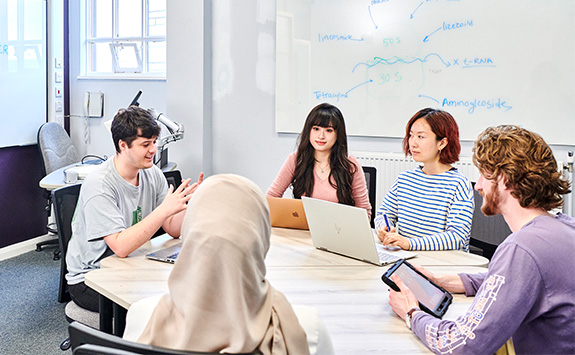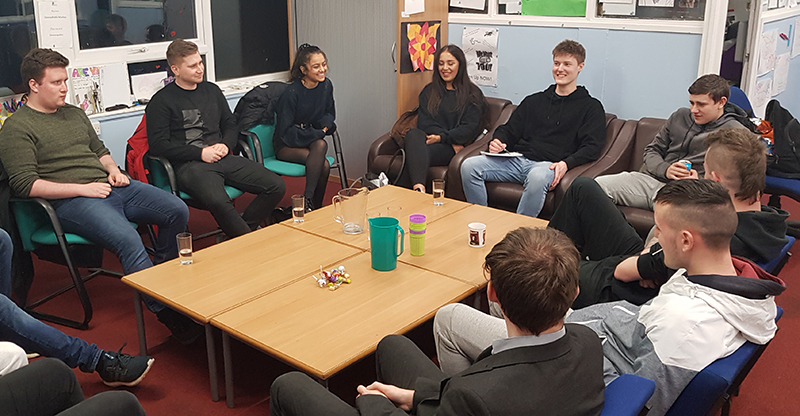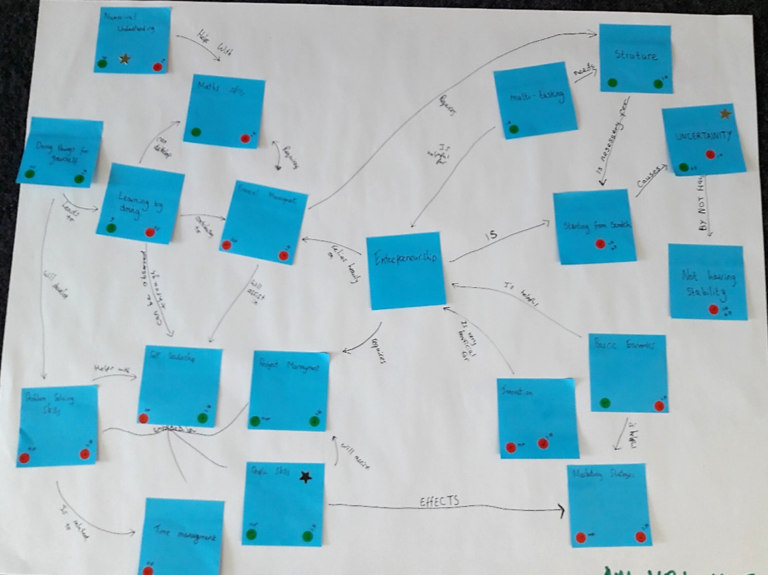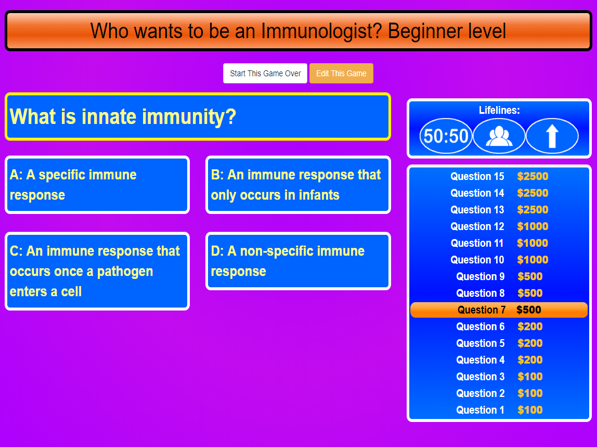Active learning
NEW: A vision for education and skills at Newcastle University: Education for Life 2030+
Active Learning
A pedagogic principle for Newcastle University and UKHE places active learning at the forefront of all in-person teaching (whether in-place or online). Students will actively participate in meaningful – and meaning-making – activities such as group discussions, problem-based learning, case study analysis, and hands-on projects that require critical thinking and the application of knowledge.
One-way transmission of information is necessary at times, but it can result in limited attention, excessive cognitive-load, and it does not engage learners in the retrieval and elaboration practices that strengthen long-term memory.
Active learning is any approach that asks students to do something with ideas—question them, apply them, debate them—rather than simply receive information. By turning listeners into participants, we give learners real agency: they co-construct knowledge, practise judgement and make their thinking visible to peers and tutors.
In addition to the cognitive and memory-retention benefits, this approach also helps support equitable access to learning by fostering inclusive environments where diverse perspectives are valued. Furthermore, by integrating activities such as case studies and problem-based learning scenarios into teaching, active learning approaches provide the opportunity for students to practice skills essential for the workplace.
Why active learning?
Having developed robust checks and balances to keep our research rigorous and reliable, we can turn our focus to how we share that knowledge with students.
Active‑learning experiences at University stand out from the wider information ecosystem, which often pushes content to passive users without promoting applied understanding or the development of skills.
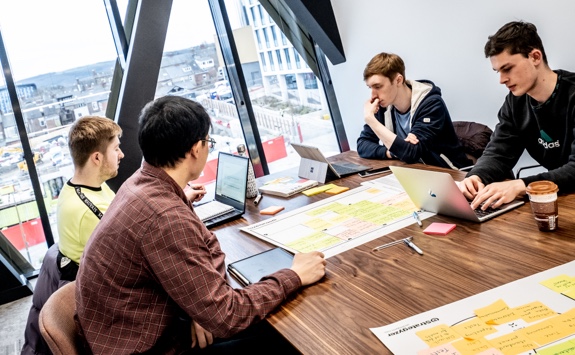
The problem is not that we learn poorly from bad lectures. The problem is that we learn poorly from very good lectures”
Active learning isn’t just better for learning—it is fairer and more future‑proof.
-
Student outcomes. Meta‑analyses show that replacing even part of a lecture with active tasks can cut failure rates by up to 45 percent and narrow the exam‑score gap between minoritised and majority students by about one‑third.
-
Career readiness. The teamwork, problem‑solving and critical thinking practised in these activities align with the graduate attributes employers value most, converting classroom effort into clear employability capital.
-
Benefits for staff. Active methods let lecturers interact with students and collect real‑time feedback. By posing a question or assigning a quick group task, they can immediately spot where students are excelling or struggling and adjust accordingly.
Active Learning
An umbrella term that encompasses many of the teaching approaches below (e.g. problem based / experiential / collaborative) that involve students – often with their peers – actively participating in the learning process beyond simply listening, reading and memorising (as opposed to passively receiving information).
Baseline
- Interactive polls: using Vevox during in-person sessions to ask short questions (either around student opinion or about key concepts).
- Quick discussion: students briefly debate a topic or question with the person sitting next to them.
Effective
- Think-pair-share: students first reflect individually, then discuss in pairs, and finally share with the larger group.
- Interactive quizzes: regular short quizzes to provide immediate feedback and reinforce key teaching.
Excellent
- Flipped classrooms: students access online content before sessions and apply concepts through activities during face-to-face sessions.
- Peer teaching: students prepare and deliver short lessons to their peers, promoting deeper understanding.
Problem-based learning
Students work, often collaboratively, to solve complex, open-ended real-world problems, which encouraging them to identify key knowledge gaps, research information independently, and critically analyse solutions in order to construct their own understanding of a subject rather than passively receiving information.
Baseline
- One‑page problem statement – assign a brief prompt for students to write what additional data they’d need to solve it, surfacing knowledge gaps.
- Mini-case studies: integrate short case studies during through sessions, asking students to collaboratively apply concepts covered to solve a practical problem.
Effective
- In-person discussions: invite students to propose solutions or strategies to a presented problem, facilitating peer-to-peer dialogue guided by colleagues.
- Two‑session PBL cycle – in week 1 groups dissect a multi‑step case, create a concept map of root issues, and set individual research tasks; in week 2 they reconvene to integrate findings and pitch a solution.
Excellent
-
Semester‑long consultancy project – teams partner with a local organisation (startup, NGO, Local Authority) to solve a real challenge; they negotiate deliverables, prototype interventions, and present to the client panel.
-
Iterative reflection & peer assessment – after each milestone, students complete structured reflections and score team contributions using a rubric aligned to professional project‑management competencies.
Learn more about Problem-based learning.
Experiential Learning
Hands-on experiences for students to help them connect abstract theory to real-world situations. It is a constructivist learning theory that involves reflection, critical analysis, and synthesis
Baseline
- Workshops and labs: hands-on sessions providing direct experience with tools, techniques, or materials central to student learning in their disciplines.
- Demonstrations and simulations: conduct short demonstrations or simulations within sessions to allow students direct observation or hands-on interaction with key concepts.
- Real-time data analysis: provide students with authentic data or examples to analyse during lectures, actively engaging them in practical decision-making.
Effective
- Field trips: visits to relevant industry locations, laboratories, museums, or community sites.
- Simulation and role-play: using realistic scenarios where students enact roles to practice professional skills.
- Guest speakers: invite guest speakers or alumni from relevant professional fields to share real-world experiences directly tied to session content.
Excellent
- Industrial placements: incorporating structured work experiences into programmes.
- Interactive 'live' case studies: facilitate interactive discussions around current events or recent developments in the discipline, allowing students to experience immediate connections between theory and practice.
Group Projects / Collaborative Learning
Students work together in groups over time to create, research and scope projects, in order to solve problems and complete tasks, fostering a social environment where learners can share ideas and learn from each other.
Baseline
- Online discussion forums: structured asynchronous online interactions, fostering continued collaboration outside sessions.
- In-class discussion: structured conversations guided by prompts, with clear expectations and outputs.
- Study groups: formalise study groups within programmes, supported by peer mentors or teaching assistants.
- Peer feedback sessions: groups critique and provide constructive feedback on each other’s work.
Effective
- Group projects: structured assignments requiring teamwork, shared responsibilities, and collective problem-solving.
Excellent
- Assessed group task - structured with careful thought towards group composition, inclusion and assessment of product and /or process. Incorporating a substantive task over multiple weeks.
Role Play and Simulation
Students adopt authentic roles (clinician, policymaker, engineer …) inside a scripted scenario or simulated environment. By acting out decisions and consequences they rehearse professional behaviours, test theoretical models and build empathy for multiple perspectives, all within a safe, low-risk setting.
Baseline
- In‑class scenario – give students a short prompt (“You’re a GP explaining test results”) and 3–4 minutes to improvise in pairs.
- Scripted read‑throughs – distribute a brief dialogue that models a real‑world exchange (e.g., client‑consultant) and have volunteers read it aloud, pausing to annotate key moves.
Effective
- Rotating roles – set up four stations (client, project manager, designer, customer); after each 10‑minute round, students rotate roles and then debrief how their decisions and interactions evolved.
- Branching‑path simulation – present a decision tree on screen; groups choose actions at each branch and immediately see the next scenario unfold, fostering discussion of consequences.
Excellent
- Full press‑conference simulation – a press briefing with trained actors portraying public officials and eyewitnesses, asking real‑time questions, and then receiving structured feedback
- Multi‑stakeholder crisis – over two weeks, teams research positions, then enact a live negotiation (cabinet meeting, media briefing) while an ‘event deck’ introduces surprise constraints.
Data Collection
Learners actively gather primary evidence—measurements, observations and survey responses —to answer a research question. The focus is on designing the method, observing ethical practice and readying the dataset for analysis, so students experience the complete inquiry cycle from raw data to insight.
Baseline
- Hallway head‑count – in pairs, students spend 10 minutes tallying how many passers‑by carry reusable cups vs. disposables, then pool numbers on a shared sheet.
Effective
- Semi‑structured interview pilot – students draft an interview protocol, secure verbal consent, record two 15‑minute interviews, transcribe key passages and code basic themes.
Excellent
- Community‑partner data drive – in collaboration with a local NGO, teams co‑design and administer a 30‑item survey to residents, manage ethics paperwork, and deliver a cleaned, annotated dataset to the partner for future policy use.
- Longitudinal self‑tracking project – each student logs daily media‑use metrics for a month using a standard template; mid‑course workshops address data cleaning and anonymisation before the cohort combines records into a rich longitudinal dataset.
Flipped Classroom
A simple reorientation of a learning episode where the content (the lecture, the reading etc…) is provided in advance and the classroom time is used for an activity that consolidates that learning.
Baseline
-
Pre‑watch & recap quiz – assign a 10‑minute screencast and open class with a short Vevox quiz to surface misconceptions before discussing answers.
-
Worked‑example walkthrough – students read a brief worked solution at home; in class they re‑solve a near‑identical problem in pairs while the instructor circulates.
Effective
- Interactive video with checkpoints – upload a 15‑minute Panopto lecture annotated with pause‑and‑answer prompts; class time is spent on small‑group case discussions and decision-making using the pre-recorded material.
Excellent
- Publication‑ready research flip Pre‑class micro‑content covers research design, ethics, and analysis techniques. Live meetings become collaborative writing studios where teams collect data, code findings, and co‑author sections of a paper under rotating faculty mentorship.
I would like to implement an experiential element to my module
1 — Scope & Align
-
Identify one of your module's learning outcomes that is pertinent to the workplace / industry / post-graduation setting
2 — Secure the Partner
-
Tap existing alumni / employer networks; start with a small, low-risk brief (4–6 weeks, one key deliverable).
-
Agree, in writing: purpose, timeline, deliverables, IP/NDAs, feedback touch-points, and a single contact on each side.
3 — Co-Design the Project
- Support students to turn the partner’s need into a clear student brief: background → task → deliverable → success criteria → resources.
4 — Prep Everyone
-
Give partners a 1-page “how to work with students” guide and calendar.
-
Run a student boot-camp: workplace etiquette, project management, data ethics, risk & safeguarding.
5 — Run & Support
-
Schedule weekly stand-ups (15 min, student-led, staff listening).
- Capture mid-point partner feedback; intervene early if scope drifts.
7 — Close & Reflect
-
Final client showcase (in-person or video) → immediate partner Q&A.
- Debrief with the partner: what worked, what to tweak, next-year ideas.
I would like to implement a Problem-Based Learning (PBL) element to my module
1 — Pin down the “problem worth solving”
-
Choose one learning outcome that demands diagnosis and solution-finding
- Frame it as a messy, authentic scenario with incomplete data—something professionals actually grapple with.
2 — Set the scope
- Decide the output: client report, prototype, policy brief, or presentation.
- Provide a template for group contracts and meeting minutes.
3 — Craft the PBL package
- Trigger: a 200–300-word case vignette, client video, or data bundle.
- Guiding questions: “What do we know? What do we need to know? Where will we find it?”
- Independent Work (between classes or over 1–2 weeks)
Teams investigate, test ideas, build drafts or prototypes. - Check-ins
Ask guiding questions, but don’t give them the answers. - Share Solutions
Teams present their best solution. The rest of the class asks questions.
I would like to implement a role play / simulation element to my module
1 — Lock onto the learning outcome
Pick one skill or concept students need to demonstrate in action: negotiating, diagnosing, policy decisions, engineering calculations, etc. e.g. “By the end, students will do X under realistic constraints.”
2 — Choose the right simulation scale
-
Micro-role (10–15 min inside a seminar): pairs act as scientist + journalist, or patient + clinician.
-
Single-class simulation (50–90 min): crisis-management meeting, courtroom debate, UN climate summit.
-
Multi-week immersive: recurring cabinet sessions, business start-up board, mock clinical rounds.
Start with the smallest version that still proves the outcome—you can always expand later.
3 — Build the scenario pack
- Trigger scenario – sets stakes, context, challenge.
- Roles – objective, background knowledge, power level, hidden info.
- Task & deliverable – e.g. “Draft a 90-second press statement.”
- Ground rules – clarify timing and etiquette
- Prep resources – key readings or data snippets for each role
6 — Facilitation and Inclusion
- Nominate a student time-keeper and recorder so you’re free to observe.
- If someone freezes, have a “prompt card” with one question or data point to reboot dialogue.
- Share role cards 24 h early for reading, translation, or screen-reader access.
- Provide an alternative analysis task for anyone who cannot—or prefers not to—act.
FIND OUT MORE
Guides and resources
The Curriculum Design Toolkit has been created to support colleagues throughout the entire curriculum development process, from initial discovery to final implementation. It addresses various stages, including programme review, discovery, and both programme level and modular level design and development.
UCL’s ABC Learning Design is an established module storyboarding method in UK HE. It provides an accessible and convenient structure for module design that helps educators design effective learning experiences.
The Institute for Experiential and Skills Based Learning is a network of academic and professional services practitioners. The website contains materials on thinking around experiential and skills based learning.
Upskill on effective practice and digital technologies, helping you to embed active learning principles in your teaching.
View Photos and Descriptions of Spaces for Collaborative Learning
Get in touch
Bibliography
Freeman, S., Et al. (2014). Active learning increases student performance in science, engineering, and mathematics. Proceedings of the National Academy of Sciences, 111(23), 8410-8415. https://doi.org/10.1073/pnas.1319030111https://math.stanford.edu/~conrad/papers/PNAS.pdf
Kapur, M. (2022). Productive Failure. International Conference of Education, Research and Innovation 2022. International Academy of Technology, Education and Development. Retrieved from https://iated.org/talks/Kapur_Productive
Sandrone S, Scott G, Anderson WJ, Musunuru K. (2021) Active learning-based STEM education for in-person and online learning. Cell. 2021 Mar 18 https://pmc.ncbi.nlm.nih.gov/articles/PMC8933058
https://www.timeshighereducation.com/campus/tried-and-tested-ways-teach-your-students-soft-skills

